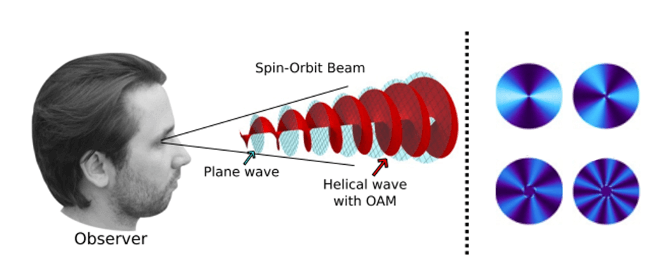Eye diseases such as macular degeneration can have a devastating impact on quality of life. Early detection and treatment are thus crucial for preventing irreversible vision loss. A previous study found that the human eye can detect differences in ‘structured’ light beams. Such light beams are composed of a coherent superposition of differently polarized planar and helical waves. This structured light can be created by coupling polarization and orbital angular momentum to form spin-orbit states with space-varying polarization profiles. The original study determined that a healthy human eye can discriminate between two different spin-orbit states by observing distinct images (i.e., the number of azimuthal fringes) induced by viewing each state. These findings will be expanded to further explore the limits of human perception of structured light. A strong association between an individual’s perception of a structured light beam and the imaging data collected from their eye with the same beam is expected. The possibility of using structured light beams to image ocular structures, including the macular pigment, the cornea, and the retina, will be investigated. Ocular imaging using structured light beams has the potential to detect subtle changes in macular pigment and other ocular structures that occur before macular degeneration progresses to the point of vision loss. Such new sensing tools could enable the early detection and treatment of macular degeneration and reduce the significant societal burden of the disease.

Figure 1. (Left) Representation of a spin-orbit beam composed of a coherent superposition of planar and helical polarized states. (Right) The number of fringes that the eye sees when viewing the spin-orbit beams.
Related Content

Quantum Simulation of Strongly Coupled Field Theories
Strongly-coupled field theories describe both fundamental and applied quantum problems.
August 10, 2017

Quantum Simulations of Fundamental Interactions
Summary To address questions in modern physics such as “what is the structure of matter inside neutron stars?” we need better computational methods to evaluate the interplay of fundamental forces between elementary particles. To-date the response to such questions rests on numerical computer simulations that are inherently limited. In this project, we develop new theoretical […]
April 18, 2019
Line-Scanning optical coherence tomography system for in-vivo, non-invasive imaging of the cellular structure and blood perfusion of biological tissue
Summary Optical coherence tomography (OCT) is an optical imaging method that allows for in-vivo, non-invasive imaging of the structure and vasculature of biological tissue. Commercially available, clinical OCT systems utilize point-scanning method to acquire volumetric images over a large surface with typical frame rates of ~ 30 frames/ second. Since living biological tissue is constantly […]
August 27, 2019

Tuning Spin-Exchange Interactions in Low-Dimensional Metal Halide Perovskites: A New Class of Semiconductor Quantum Materials
Summary Leakage current in electronic components is one of the limiting factors for the performance of conventional computers which use charges and currents as physical information carriers. Spintronics offers an alternative by using electron spin for information transfer, processing and storage, enabling the design of non-volatile computer memory and more energy-efficient electronic devices. In this […]
October 1, 2019

